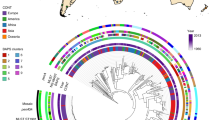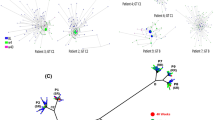Abstract
Genital herpes, caused by herpes simplex virus, is the most prevalent sexually transmitted disease worldwide. In many developing countries genital herpes is untreated, and in the United States only 10% of cases are treated. We present a mathematical model that we use as a health policy tool to predict the levels of antiviral drug resistance that would emerge, if treatment rates were increased, and to identify the key factors in determining the emergence of drug resistance. We use our results to suggest control measures for herpes epidemics that would prevent the emergence of substantial levels of antiviral drug resistance.
This is a preview of subscription content, access via your institution
Access options
Subscribe to this journal
Receive 12 print issues and online access
$209.00 per year
only $17.42 per issue
Buy this article
- Purchase on Springer Link
- Instant access to full article PDF
Prices may be subject to local taxes which are calculated during checkout
Similar content being viewed by others
References
Fleming, D.T. et al. Herpes Simplex Virus type 2 in the United States, 1976 to 1994. N. Engl. J. Med. 337, 1105–11 (1997).
Nahmias, A.J., Lee, F.K. & Beckman-Nahmias, S. Sero-epidemiological and sociological patterns of herpes simplex virus infection in the world. Scand. J. Infect. Dis. 69, 19–36 (1990).
Oberle, M.W. et al. Herpes simplex virus type 2 antibodies: high prevalence in monogamous women in Costa Rica. Amer. J. Trop. Med. Hyg 41, 224–229 (1989).
Marchant, J. & Roe, A. Genital herpes: recognizing and addressing patients's needs. Herpes Journal 4, 36–41 (1997).
Wildy, P., Field, H.J. & Nash, A.A. Classical herpes latency revisited. Soc. Gen. Microbiol. Symp. 33, 133–167 (1982).
Mertz, G.L., Schmidt, O. & Jourden, J.L. Frequency of acquisition of first episode genital infection with herpes simplex virus from symptomatic and asymptomatic source contacts. Sex. Tramm. Dis. 12, 33–39 (1985).
Reichman, R.C. et al. Treatment of recurrent genital herpes simplex infections with oral acyclovir: a controlled trial. J. Am. Med. Assoc. 251, 2103–2107 (1984).
Straus, S.E. et al. Suppression offrequently recurring genital herpes: a placebo-controlled double-blind trial of oralacyclovir. N. Engl. J. Med. 310, 1545–1550 (1984).
Collins, P. & Darby, G. Laboratory studies of herpes simplex virus strains resistant to Acyclovir. Rev. Med. Virol. 1, 19–28 (1991).
Larder, B.A. & Darby, G. Selection and characteristics of acyclovir-resistant herpes simplex virus type 1 mutants inducing altered DNA ploymerase activities. Virology 146, 262–271 (1985).
Darby, G., Field, H.J. & Salisbury, S.A. Altered substrate specificity of herpes simplex virus thymidine kinase confers acyclovir-resistance. Nature 289, 81–83 (1981).
Safrin, S. et al. A controlled trial comparing foscarnet with vidarabine for acyclovir-resistant mucocutaneous herpes simplex in the acquired immunodeficiency syndrome. N. Engl. J. Med. 325, 551–555 (1991).
Hook, E.W. et al. Herpes simplex virus infection as a risk factor for human immunodeficiency virus infection in heterosexuals. J. Infect. Dis. 165, 251–255 (1992).
Blower, S.M. & McLean, A.R. Prophylactic vaccines, risk behavior change and the probability of eradicating HIV in San Francisco. Science 265, 1451–1454 (1994).
Blower, S.M., Small, P.M. & Hopewell, P. Control strategies for tuberculosis epidemics: new models for old problems. Science 273, 497–500 (1996).
Blower, S.M. & Gerberding, J.L. The Dynamics of Drug Resistant Tuberculosis: A Theoretical Framework. J. Mol. Med. (In the press).
Whitely, R.J. & Gnann, J.W. Acyclovir: a decade later. New Engl. J. Med. 327, 782–789 (1992).
Kaplan, E.H. Economic evaluation and HIV prevention community planning - A policy analysts's perspective. in Handbook of HIV Prevention Policy Analysis (ed. Holtgrave,D.) (In the press).
Wald, A., Zeh, J., Barnum, G., Davis, L.G. & Corey, L. Suppression of subclinical shedding of herpes simplex virus type 2 with acyclovir. Ann. Intern. Med. 124, 8–15 (1996).
Safrin, S. Cherrington, J. & Jaffe, H.S. Clinical use of cidofovir. Rev. Med. Virol. 7, 145–156(1997).
Iman, R.L. & Helton, J.C. An investigation of uncertainty and sensitivity analysis techniques for computer models. Risk Analysis 8, 71–90 (1980).
Mckay, M.D., Beckman, R.J. & Conover, W.J. A comparison of three methods for selecting values of input variables in the analysis of output from a computer code. Technometrics 21, 239–245 (1979).
Blower, S.M., Hartel, D., Dowlatabadi, H., May, R.M. & Anderson, R.M. Drugs, sex and HIV: a mathematical model for New York City. Phil.Trans. Roy Soc. Series B 321, 171–187(1991).
Blower, S.M. & Dowlatabadi, H. Sensitivity and Uncertainty Analysis of complex models of disease transmission: an HIV model, as an example. Int. Statist. Rev. 62, 229–243 (1994).
Blower, S.M. et al. The intrinsic transmission dynamics of tuberculosis epidemics. NatureMed. 1, 815–821 (1995).
Sanchez, M.A. & Blower, S.M. Uncertainty and sensitivity analysis of the basic reproductive rate: Tuberculosis as an example. Am. J. Epidemiol. 145, 1127–1138 (1997).
Porco, T.C. & Blower, S.M. Quantifying the intrinsic transmission dynamics of tuberculosis. Theor. Popul. Biol. (in the press).
Porco, T.C. A mathematical model of the ecology of Lyme disease. IMAJ. Math. Appl. Med. Biol. (in the press).
Kost, R.G., Hill, E.L., Tigges, M. & Straus, S.E. Recurrent acyclovir-resistant genital herpes in an immunocompetent patient. N. Engl. J. Med. 329, 1777–1782 (1993).
Englund, J.A. et al. Herpes simplex virus resistant to acyclovir. Ann. Intern. Med. 112, 416–422 (1990).
Wade, J.C., McLaren, C. & Meyers, J.D. Frequency and significance of acyclovir-resistant herpes simplex virus isolated from marrow transplant patients receiving multiple courses of treatment with acyclovir. J. Infect. Dis. 148, 1077–1082 (1983).
Barry, D.W., Nusinoff-Lehrman, S., Ellis, M.N., Biron, K.K. & Furman, P.A. Viral resistance, clinical experience. Scand. I. Infec. Dis. Suppl. 47, 155–164 (1985).
Mertz, G.J., Benedetti, J., Ashley, R., Selke, S. & Corey, L. Risk factors for the sexual transmission of genital herpes. Ann. Intern. Med. 116, 197–202 (1992).
Mertz, G.J. et al. Transmission of genital herpes in couples with one asymptomatic and one asymptomatic partner: a prospective study. J. Infect. Dis. 157, 1169–77 (1988).
Wald, A., Zeh, J., Selke, S., Ashley, R.L. & Corey, L. Virologic characteristics of sub-clinical and symptomatic genital herpes infections. N. Engl. J. Med. 333, 770–775 (1995).
Benedetti, J., Corey, L. & Ashley, R. Recurrence rates of genital herpes after acquisition of symptomatic first episode infection. Ann. Intern. Med. 121, 847–54 (1994).
Author information
Authors and Affiliations
Rights and permissions
About this article
Cite this article
Blower, S., Porco, T. & Darby, G. Predicting and preventing the emergence of antiviral drug resistance in HSV-2. Nat Med 4, 673–678 (1998). https://doi.org/10.1038/nm0698-673
Received:
Accepted:
Issue Date:
DOI: https://doi.org/10.1038/nm0698-673
This article is cited by
-
Computational and Theoretical Analysis of the Association Between Gender and HSV-2 Treatment Adherence
Acta Biotheoretica (2021)
-
Antiviral prophylaxis during pandemic influenza may increase drug resistance
BMC Infectious Diseases (2009)
-
Dynamic Modeling of Herpes Simplex Virus Type-2 (HSV-2) Transmission: Issues in Structural Uncertainty
Bulletin of Mathematical Biology (2009)
-
Evaluating the Performance of Chemical Control in the Presence of Resistant Pathogens
Bulletin of Mathematical Biology (2007)
-
Modelling entomological-climatic interactions of Plasmodium falciparum malaria transmission in two Colombian endemic-regions: contributions to a National Malaria Early Warning System
Malaria Journal (2006)



